
views
Getting Rid of Clothing Stains
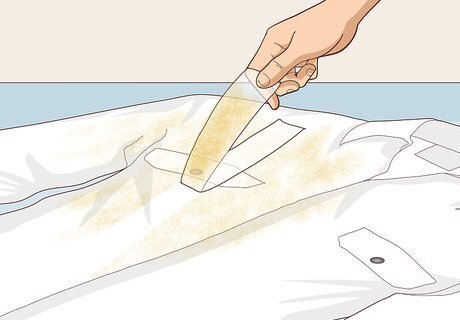
Lift away any visible pollen with clear tape. Rip away a 1 in (2.5 cm) section of sticky tape and arrange it on top of the pollen stain. Press the tape into place with your finger, then gently remove the adhesive from your clothing. Repeat this process several times, or until any visible pollen is gone. If you don’t remove the pollen from your clothing, you might end up smearing it into the stain, which will make it worse. Feel free to use multiple pieces of tape for this.
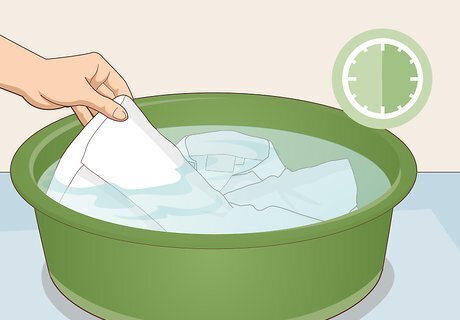
Submerge the garment in cool water for 30 minutes. Fill a large basin about halfway with cool tap water. Next, arrange your clothing in the water so it‘s completely drenched. Leave your garment in the basin for a half hour, so the stain can fully soak. Make sure that there’s enough water in the basin to submerge your garment completely.Warning: Don’t soak or wash any items that are specified for just dry-cleaning.

Place the article of clothing in direct sunlight for at least 3 hours. Remove the soaking garment from the basin and wring it out over a sink. Once the item is no longer dripping wet, drape it over a flat, sunny surface. Let the article of clothing sun-dry for several hours, so the stain can lift away naturally. This works best with pale, light-colored garments. A deck, porch, or clothesline is a great source of direct sunlight.

Apply a spot remover if natural methods don’t remove the stain. If the pollen stain is still visible after you’ve soaked and dried your garment, pour a grape-sized amount of spot remover onto a cloth or paper towel. With short, careful motions, dab the spot remover onto both sides of the flower stain. For the stain treatment to be more effective, let the cleaning agent soak for 2 minutes before going in the washer. Always check the care label of a clothing item before using any spot removers or cleaning solvents.
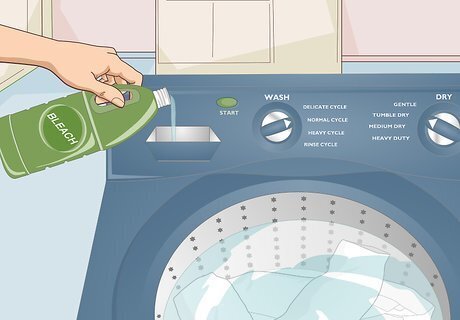
Wash your clothing with bleach if the care label allows it. Check the label or tag on your garment to find the washing and drying instructions. If the clothing label allows it, pour the recommended amount of bleach into your washing machine, along with your usual laundry detergent. Set your washer to the highest possible temperature before starting the cycle. If your garment can’t be washed with bleach, wash the garment without it. Follow the instructions provided on the container whenever you use bleach. Use bleach as a last resort.
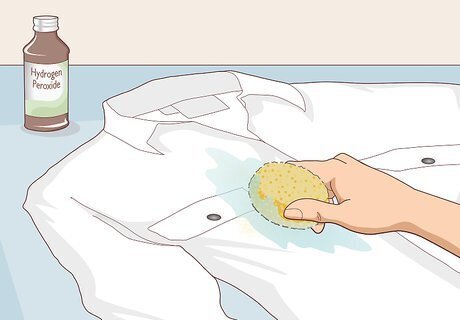
Sponge hydrogen peroxide onto the spot if the stain is still there. Using quick, delicate motions, dab the solution onto the visible flower stain. Continue pressing and treating the spot until the pollen stain begins to disappear. If you don’t have hydrogen peroxide on hand, use rubbing alcohol instead. When handling delicate fabrics like acetate, water down the hydrogen peroxide with a few drops of water. While removing a stain, air-dry the garment instead of putting it in a tumble dryer.
Treating Stains on Upholstery and Carpet
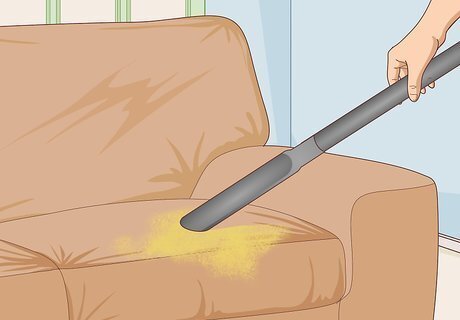
Vacuum up any visible pollen from your furniture or floor. Use the tube attachment or a handheld vacuum on a low pressure setting to suck up any pollen and dust lingering on top of the stain. If your upholstery isn’t especially delicate or sensitive, try using a few strips of clear tape to remove any loose pollen from the surface. If you rub any loose pollen into the furniture, you could end up making the flower stain worse.
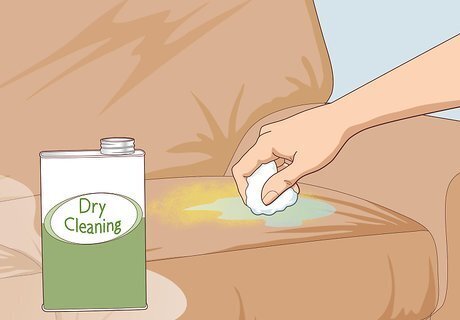
Dab a dry-cleaning solvent over the stained area. Read the label of your dry cleaning solvent and see which materials it can be used on. If it’s safe to use on your furniture, pour a grape-sized amount of solvent onto a cloth or paper towel. Using quick, cautious movements, apply the solvent to the surface of the flower stain. You can purchase dry-cleaning solvents online or at any store that sells laundry supplies.
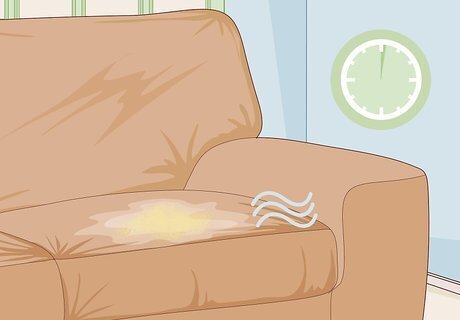
Wait at least 1 hour for the item to air-dry. Step away from the upholstery, allowing the solvent to soak and evaporate from your furniture. After about 60 minutes have passed, lightly tap the surface of the stain to see if the upholstery is still damp. If the material is moist, wait another 30-60 minutes before checking again. If you used a lot of stain removing mixture, the liquid will take longer to evaporate.
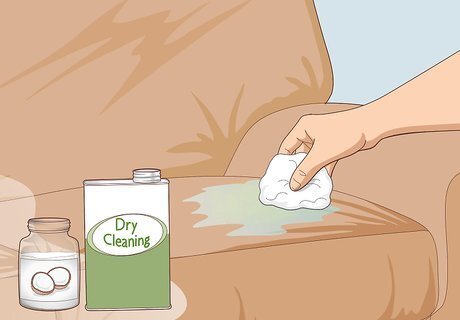
Treat stubborn spots with a mixture of coconut oil and dry-cleaning solvent. Mix 1 tablespoon (15 mL) of coconut oil with 8 tablespoons (120 mL) of dry-cleaning solvent together in a small bowl. Once you’ve stirred these ingredients together, pour the mixture onto a cleaning pad or cloth. Arrange this cloth over the problem spot, and replace it once the pad soaks up the stain. Always mix coconut oil and cleaning solvent in a 1:8 ratio. You can use any clean, absorbent item to soak up the stain. Soak the pad with more stain-removing solution as needed.
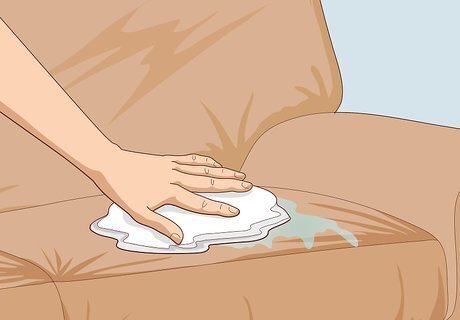
Blot away any excess solution so the item can dry. Take a clean sponge or towel and press along the damp section of your furniture. Work in quick, delicate motions, soaking up as much liquid as you can. Once you’ve blotted away any excess cleaning mixture, let the upholstery air-dry for several hours. Tap the upholstery periodically to see if it’s dry.
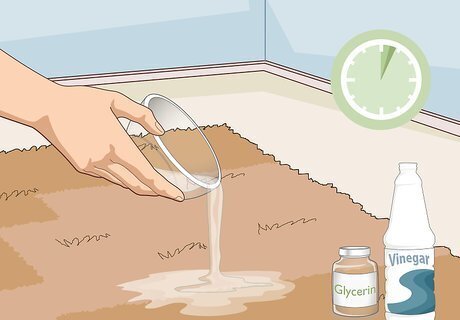
Pour a glycerin mixture on carpet stains and let it soak for 2-4 minutes. Mix 2 tablespoons (30 mL) of oxalic acid, 1 tablespoon (15 mL) of white vinegar, and 8 tablespoons (120 mL) of glycerin together in a small bowl. Next, add in a few drops of butyl alcohol until the mixture no longer looks opaque. After stirring these ingredients together, pour a small amount of the mixture over the stain. Once you’ve applied the cleaning solution, let it soak for 2-4 minutes. This mixture works best with natural, synthetic, blended, wool, jute, and hemp fibers. If your carpet is made with acetate, acrylics, triacetate, or modacrylics, be sure to dilute the alcohol with water at a 1:2 ratio (e.g., 1 drop alcohol, 2 drops water). When working with cotton- or linen-based carpet fibers, add 2 tablespoons (30 mL) of water into the cleaning mixture. You can find glycerin in most drug stores, and oxalic acid in many hardware stores.

Flush out the glycerin mixture with cool water. Pour a small amount of water over the stained section of carpet to get rid of any remaining glycerin, vinegar, and oxalic acid in the fibers. Using clean cloths or paper towels, soak up any excess water from the carpet. Let this section of carpet dry for several hours, or until it’s dry to the touch. You can also soak up the extra with a wet vacuum, if you have one on hand.
Cleaning off Hard Surfaces
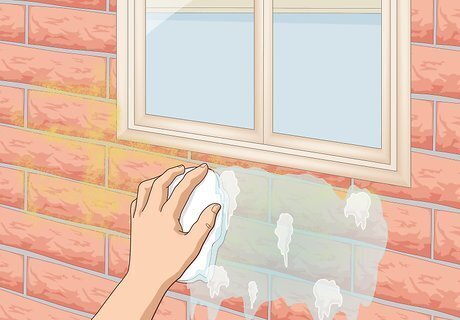
Wipe off brick, concrete, and stone with a mixture of water and detergent. Pour a grape-sized amount of laundry detergent into a large bucket of water. After stirring these ingredients together, dip a soft-bristled into the soapy mixture and start scrubbing the flower stain. To get rid of any leftover suds, wipe off the hard surface with a water-soaked cloth or paper towel. If you’re working outdoors, you can use a hose to rinse off the leftover suds. You can also use washing soda instead of detergent. If you need something more acidic for non-porous surfaces, you can use Bar Keepers Friend.
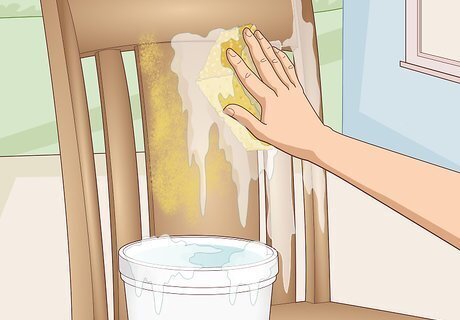
Remove pollen stains from wooden surfaces with soapy water. Pour a grape-sized amount of mild soap into a bucket or basin of lukewarm water. Once you’ve created a sudsy mixture, wipe down the pollen-stained wood with a sponge. To rinse off the soap, soak the sponge in clear water, then wipe off the wood once more. You can use Dawn dishwashing detergent to remove stains.
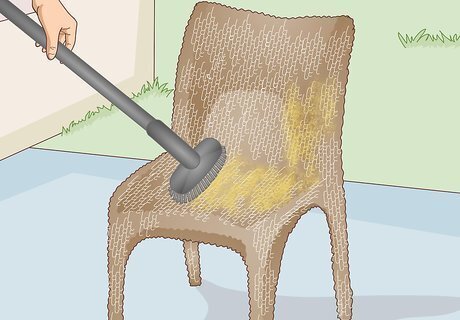
Use a vacuum or duster to remove pollen from wicker furniture. Examine your outdoor wicker furniture for any latent pollen stains or dust. Before cleaning off the furniture, use a feather duster or vacuum attachment to suck up any excess pollen laying on your wicker. If you try to brush or smear the pollen away, you could end up making the stain worse.
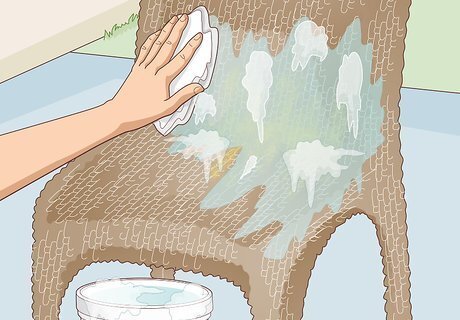
Get rid of persistent pollen stains on wicker with soap and water. Pour a drop of mild soap onto a clean cloth or paper towel, then drench the rag in warm water. To get rid of pollen stains, use the soapy cloth to wipe down the surface of the wicker. Once you’ve cleaned off the furniture, use a water-soaked rag to rinse off any leftover soap.




















Comments
0 comment